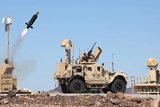New Zealand turns to proven UAS to meet rapid procurement for army
Thousands of Black Hornet nano-UAS have been in service worldwide and the new version, Black Hornet 4, was released two months ago. (Photo: Teledyne Flir)
The New Zealand Army will operate three levels of UAS under contracts awarded earlier this month with deliveries expected to begin in 2024 but possibly within months in some cases.
The provision of three UAS comes under Network Enabled Army (NEA) Intelligence, Surveillance and Reconnaissance (ISR) which is included under the broader NEA programme.
The NEAISR programme began life in August 2019 to deliver a system, including sensors and intelligence processing capability, to the New Zealand Army to improve situational awareness and support deployed commanders’ decision-making at all levels.
The RfP closed in July 2022 with an emphasis on military-off-the-shelf
Already have an account? Log in
Want to keep reading this article?
More from Land Warfare
-
![HIMARS arrive in Hawaii as first multinational launch in Australia takes place]()
HIMARS arrive in Hawaii as first multinational launch in Australia takes place
The M142 High Mobility Artillery Rocket System (HIMARS) launcher is in high demand with Lockheed Martin doubling speed of manufacture since Russia’s invasion of Ukraine. As orders are racked up in Europe, the Indo-Pacific region is seeing the increasing presence of the system.
-
![Ireland’s Reamda develops new version of Riddler UGV]()
Ireland’s Reamda develops new version of Riddler UGV
The company's Riddler uncrewed ground vehicle (UGV) is designed to be small and light to allow easy deployment and the ability to access smaller areas such as bus or train aisles.
-
![Spain to invest billions of dollars on howitzers and other vehicles as it looks to select new tanks]()
Spain to invest billions of dollars on howitzers and other vehicles as it looks to select new tanks
The Spanish Government has outlined plans to purchase communications and cybersecurity capabilities but most notably amphibious combat vehicles, self-propelled howitzers (SPHs), bridge-laying vehicles and an effort to replace its tanks from 2040.
-
![What does Germany’s new tank joint venture mean for MGCS?]()
What does Germany’s new tank joint venture mean for MGCS?
Germany is Europe’s leading country for tank manufacture and until this month was committed to the Franco-German Main Ground Combat System (MGCS) which included tanks and other vehicles. Earlier this month, Germany and other European countries set up the Main ARmoured Tank of Europe (MARTE) project casting a shadow over the MGCS.
-
![CAVS rolls on as Denmark orders 129 vehicles]()
CAVS rolls on as Denmark orders 129 vehicles
Denmark signed the Technical Arrangement for the multinational Common Armoured Vehicle System (CAVS) in April this year. The order means the country will receive its first vehicle this year.
























